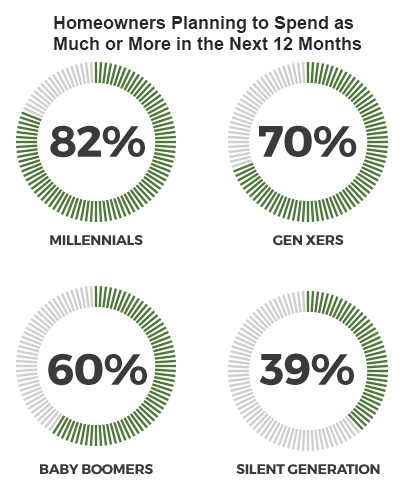HomeAdvisor Released New True Cost Report Highlighting Home Improvement Trends
HomeAdvisor has released its True Cost Report focused on generational trends in home improvement, the negligible impact of rising interest rates on homeowner decision making and the growth of home improvement spending. Findings of the report show that 84 percent of homeowners surveyed plan to stay in their existing homes rather than move, and as a result are planning to spend more on home improvement projects this year, with half of all respondents considering a remodel.

The report, authored by HomeAdvisor’s Chief Economist Brad Hunter, provides insight into homeowner spending trends and the primary factors influencing home project decision-making, including age group, region, interest rates and consumer confidence.
The report shows that millennials, for whom homeownership rates are increasing rapidly, are more likely than any other generation to remodel any part of their home and take on the highest number of projects. Millennial homeowners have completed more home projects per household in the last 12 months than homeowners in any other generation, surpassing the silent generation, baby boomers and Gen Xers by 72 percent, 42 percent and 18 percent, respectively.
While millennials have a higher propensity to tackle these improvements, they don’t spend nearly as much as baby boomers to complete them.

“Most millennials have had to compromise on the size and condition of their starter homes — with many purchasing older homes in need of repair just to be able to afford homeownership,” said Hunter. “Many of the millennials who bought a home in the last few years are seeking to upgrade. But a lack of housing inventory, coupled with inflated home prices and rising mortgage rates, has them renovating their existing homes instead of selling and moving.”
Additional Highlights from the 2018 True Cost Report include:
- Millennials are not only more likely than any other generation to remodel any part of their homes, but they’re twice as likely as baby boomers to complete bathroom and kitchen remodeling projects.
- Millennials have completed the most home projects in the past 12 months — 72 percent more, 42 percent more and 18 percent more projects than the silent generation, baby boomers and Gen Xers, respectively.
- Five in six millennials plan to spend as much or more on home improvements in the coming 12 months as they did last year, with more than half of millennials expecting to spend more.
- Homeowners spent an average of $6,649 on home improvements per household in the last 12 months.
- The majority of homeowners say they’re planning to spend as much or more on home improvements in the coming year with a heavy focus on cosmetic enhancements such as painting, landscaping and remodeling.

The report is informed by HomeAdvisor’s True Cost Guide, an online guide for homeowners to access real costs as reported by consumers for home projects, as well as results from an annual survey conducted among homeowners. To view the complete report, visit HomeAdvisor’s 2018 True Cost Report page here: https://www.homeadvisor.com/r/true-cost-report/
Article originally published on kbbonline.com








